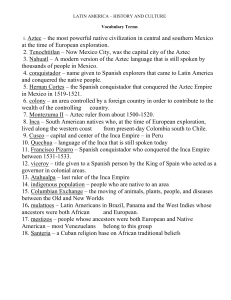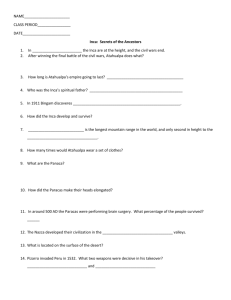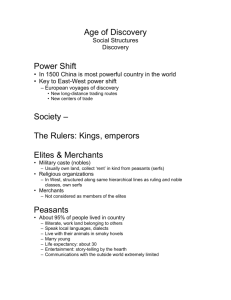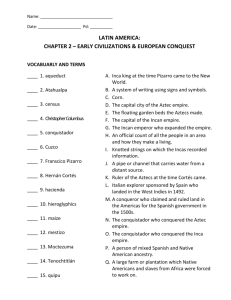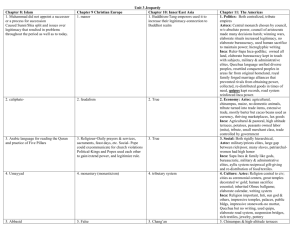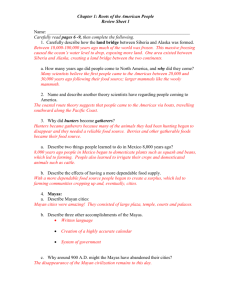Aztec Inca Part 3
advertisement
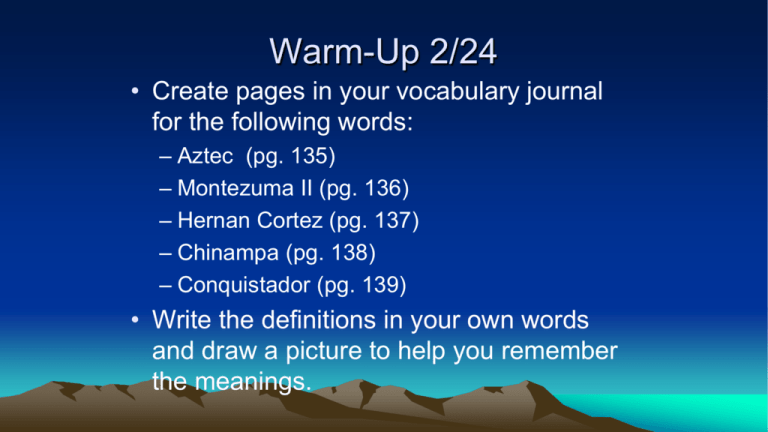
Warm-Up 2/24 • Create pages in your vocabulary journal for the following words: – Aztec (pg. 135) – Montezuma II (pg. 136) – Hernan Cortez (pg. 137) – Chinampa (pg. 138) – Conquistador (pg. 139) • Write the definitions in your own words and draw a picture to help you remember the meanings. Montezuma II • Montezuma II was an Aztec ruler from about 1500 to 1520 • He is most famous for ruling the Aztec when their land was invaded by the Spanish conquistador Hernan Cortes • Montezuma had spread the Aztec empire over a large part of central and southern Mexico • The Native Americans conquered by Montezuma had to pay him high taxes and had to send him humans for sacrifice in the temples of the Aztec • Because of the taxes and sacrifices, Montezuma was unpopular with those he conquered • Montezuma was popular with his own people, however, and was considered a great ruler • When Cortes and his army came to Tenochtitlan, Montezuma was alarmed • Many people, including Montezuma, believed Cortes to be the returning god Queztcoatl • Montezuma ordered that Cortes and his men be welcomed into the city • They were given grand gifts and gold – Some believe that Montezuma acted this way in the hopes that Cortes would take the gifts and leave • Instead, Cortes took Montezuma hostage and ruled for some time while Montezuma was a prisoner in his own palace • In 1520, a fight broke out between Spanish troops and Aztec warriors • The battle grew and Montezuma was killed and the Spanish conquest was complete Inca Civilization • The Inca lived along the western coast of South America • Their lands stretched over 2,000 miles from presentday Colombia south to Chile • Their empire was centered at their capital in Cuzco, Peru. • They also controlled lands in present-day Argentina, Bolivia, and Ecuador • The Inca were known for many great achievements – They made beautiful gold, silver, and bronze pieces – Their leader even had rooms of gold and silver in his palace • They were also known for skillfully made textiles • They also built a network of roads allowing them to quickly move around their empire • The Inca also managed to farm in difficult areas by building terraces on the mountainsides of the Andes mountains where they lived • Although it is not totally understood today, they had a system of mathematics and accounting • These achievements helped the Inca become the wealthiest of the natives peoples in the New World • Historians believe that the Inca empire began in the early 1400s • They were in a time of expansion when the Spanish arrived • The Inca leader had been killed and, without a clear leader, the Inca people were unable to push back to invading Spanish • The Spanish settlers wiped out much of the Inca culture and ruled for nearly 300 years • Today, however, there is still evidence of the Inca • Their language, Quechua, is still spoken and their terraces are still used for farming, and textiles made today are very similar to those made 500 years ago. Francisco Pizarro & Atahualpa • Francisco Pizarro was a Spanish conquistador • He is famous for conquering the Inca Empire in South America between 1531 and 1533 • Pizarro was born in Spain in 1475 • He was a pig farmer as a boy • As a young man he joined a ship traveling for the New World • In 1502, at the age of 27, he landed on the island of Hispaniola • He learned a lot about exploration and conquering the native people • He traveled with Vasco Nunez de Balboa on his famous exploration of Central America in which Europeans first sighted the Pacific Ocean • In 1523, he led a voyage to explore the west coast of South America, south of Panama • He came across some Indian traders who told of a rich country to the south • He learned that these people were the Inca and that they lived in the area of what is now Peru • Over the next few years, Pizarro went back to Spain to get permission to invade and conquer the Inca • The Spanish king gave Pizarro permission to take the Inca land and claim it as part of Spain • He made Pizarro viceroy (governor) over the lands stretching six hundred miles south from Panama • He also gave him three ships, about two hundred men, and three dozen horses to make his plan work • Pizarro began his mission in 1531 • Atahualpa was the last ruler of the Inca empire • Inca land stretched 2,000 miles along the Pacific Coast of South America • Atahualpa was the son of the Inca emperor Huayna Capac • After his father’s death, Atahualpa fought against his brother for control of the empire • Atahualpa won the battle and became the Sapa Inca • The Sapa Inca was thought to be a living descendant of the sun god

